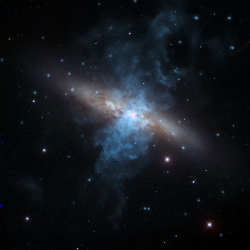 HEAPOW: The Pulsing ULX (2014 Oct 13)
HEAPOW: The Pulsing ULX (2014 Oct 13)
The nature of the so-called Ultraluminous X-ray sources (or ULXs) is one of the outstanding mysteries in high-energy astronomy. These objects are so bright in X-rays that they violate the "Eddington Limit", in which the outward pressure of the radiation that a source produces balances the inward pull of of the object's self-gravity. In order to explain the existence of such objects, astrophysicists had to resort to extreme scenarios: a new class of "middleweight" black holes with masses of tens or thousands of times the mass of the sun. But thanks to a new observation with the NuSTAR hard X-ray observatory, astronomers have shown that the ULX population now includes at least one neutron star. The ULX in question is the source known as X2, in the starburst galaxy M82. A composite Chandra X-ray Observatory X-ray image in blue and ground-based optical image is shown above; the source X-2 is one of the bright objects near the center of the galaxy. The NuSTAR observations uncovered an X-ray pulsation in the source, in which the X-rays flash with a period of 1.37 seconds. Furthermore, the X-ray pulse period changes every 2.5 days. The pulses must originate near the surface of a neutron star, an unbelievably dense dead stellar core left behind after a supernova, spinning with a period of 1.37 seconds in a 2-5 day orbit around a more massive companion. The extreme brightness of this pulsar is a puzzle. The X-ray emission is believed to be powered by accretion of material pulled from the companion star onto the neutron star, but it's an open question at the moment how a neutron star, with a mass of little more then the mass of the Sun, can pull so much material from the companion to power the extreme X-ray luminosity observed.
MSFC: Suspected Black Hole Unmasked as Ultraluminous Pulsar
CXC: M82X-2: Suspected Black Hole Unmasked as Ultraluminous Pulsar
http://asterisk.apod.com/viewtopic.php?t=33949
An ultraluminous X-ray source powered by an accreting neutron star - Matteo Bachetti et al
- Nature 514(7521) 202 (09 Oct 2014) DOI: 10.1038/nature13791
| << Previous HEAPOW | High Energy Astrophysics Picture of the Week | Next HEAPOW >> |